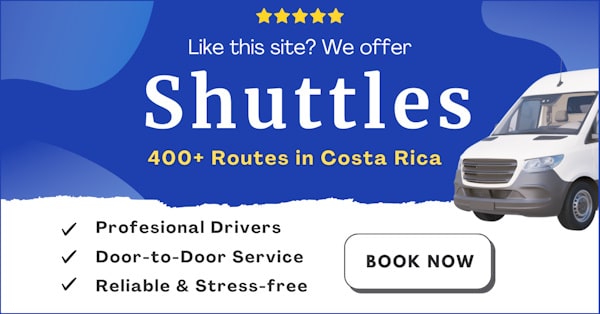Last Updated: June 6, 2025
Traveling to Costa Rica with kids takes a little extra planning. You have to think about what to pack, how best to get around, and other important logistics. One of those things that often leaves parents perplexed is what to do about car seats.
We live in Costa Rica with our kids and have been helping families arrange travel here since 2013. In this post, we will give you an idea of what to expect when it comes to car seats in Costa Rica. We’ll let you know about the car seat laws, types of seats available, and how it will work with a rental car, and on tours or shuttles.
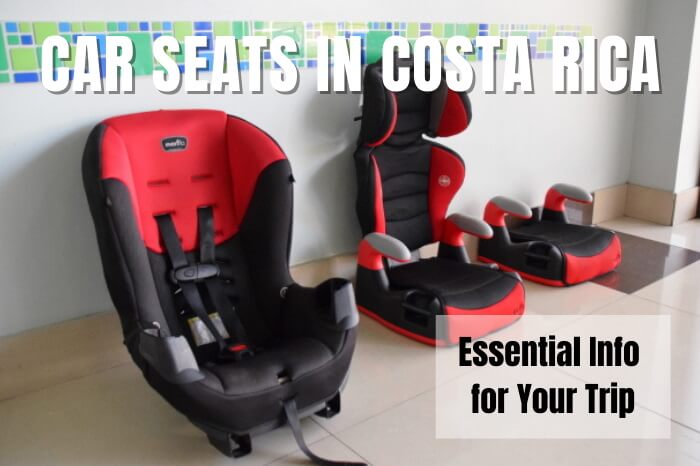
Car Seats in Costa Rica
Legal Requirements
By law in Costa Rica, car seats or booster seats are mandatory for children 12 and under, up to 57 inches/145 cm or 79 pounds/36 kg. Here are the specific laws:
Infants up to one year (up to 28.5 pounds/13 kg or 29.5 inches/75 cm) – Rear facing in the middle seat.
Babies and children ages 1-4 (20-40 pounds/9-18 kg or up to 43 inches/110 cm) – Front facing in the middle seat.
If you have more than one child, the one who weighs less should be in the middle and the other behind the passenger seat.
Children ages 4-6 (33-55 pounds/15-25 kg or up to 57 inches/145 cm) – Booster seat with a back.
Children ages 6-12 (48.5-79 pounds/22-36 kg or up to 57 inches/145 cm) – Booster seat without a back.
These requirements can be found in La Nacion newspaper. Or find a translated version here.
Practical Considerations
Although these are the car seat requirements in Costa Rica, they are not always followed.
In rural areas, it is common to see young children, including babies, sitting on their mom’s lap in the back seat. Sometimes you will even see kids sandwiched between their parents on a motorcycle, cruising down the road!
The fines for non-compliance with car seat laws are hefty, though. So we highly recommend getting whatever seat your child is required to have. We have heard of people getting fined by Transito (Costa Rica’s transit police) for not having their kids in seats.
Keep in mind too that Costa Rica is not the safest place for driving, so it is good to have the kids properly restrained.
What Car Seats Are Available in Costa Rica?
Rental Cars
Overview
If you’re renting a car, which is what we usually recommend for families, the rental car company will have car seats available.
The types of seats vary depending on the company you use. But generally, they all have convertible seats for babies and toddlers, booster seats with a back, and backless booster seats for older children. Some will have infant bucket seats for smaller babies.
The brands/models vary considerably. Reputable companies usually have name brands that you will recognize, like Graco, Evenflo, Safety First, etc.
Typically, there is an extra daily charge for car seats of around $6 per day.
Car Seats Through Adobe Rent a Car
If you’re thinking of renting a car, check out our Rental Car Discount through Adobe Rent a Car. They are a reputable company with reliable cars. Adobe has been around for 20 years and has offices all around the country.
A big plus for families is that Adobe gives Two Weeks in Costa Rica readers free car seats when booked through our website. You can use the form on our Rental Car Discount page to check availability and rates for your dates.
Adobe Rent a Car has three types of car seats available: convertible seats, boosters with a back, and boosters without a back. Some offices also have infant bucket seats. The exact inventory will vary.
Here is more information on Adobe Rent a Car’s most common car seats. When you go to reserve, just indicate in the notes section which car seat(s) you’ll need.
Convertible Seat
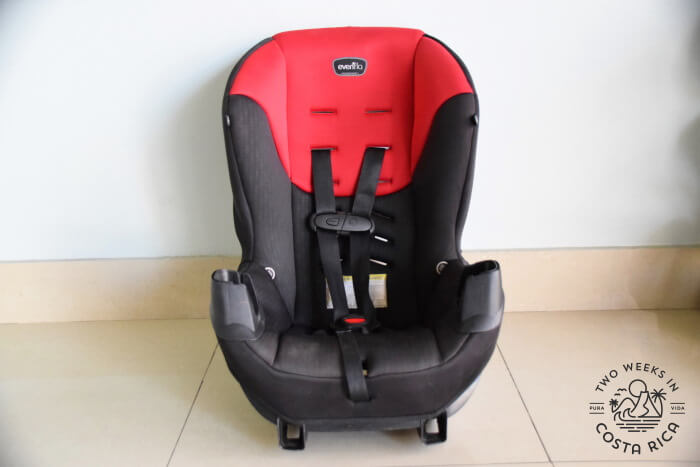
This seat is for babies and children ranging from 5-65 lbs. It has a 5-point harness and 6 shoulder positions for adjusting the harness height. The seat goes rear facing up to 40 lbs and front facing up to 65 lbs. Maximum height: 50 inches.
*Because this seat goes up to 65 lbs front facing, it can be used for kids in the ages 3-6 range (depending on size) who you want to keep in a 5-point harness.
Booster with a Back
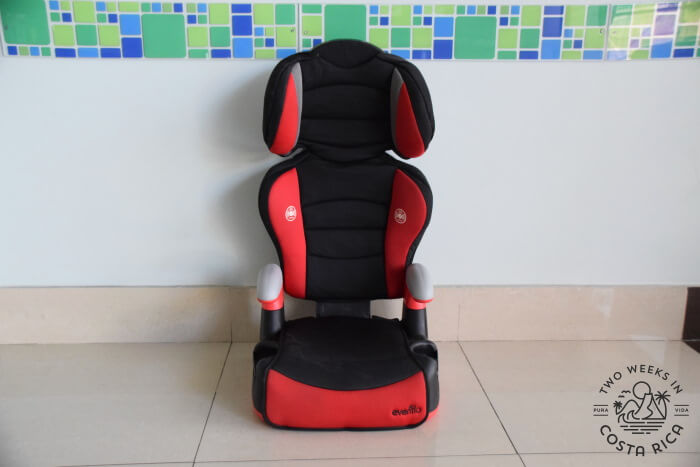
This seat is for children from 40-110 lbs, 40-57 inches, and at least 4 years old. It uses the seat belt (no 5-point harness) as the restraint.
No Back Booster
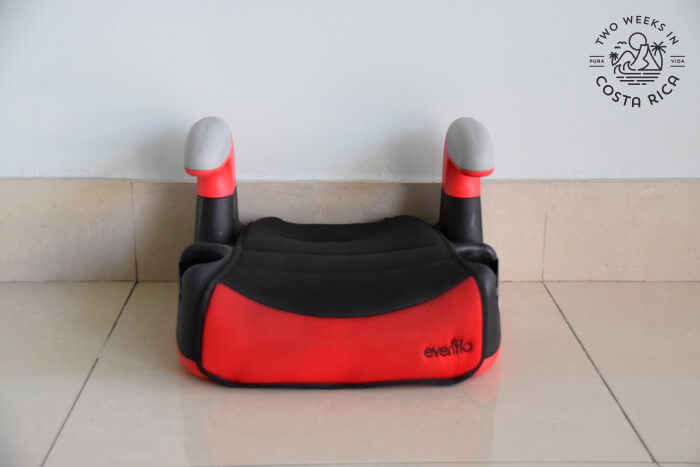
This is for older kids who don’t need a high-back booster anymore.
Shuttle Vans
If you’re planning to take shuttle transfers between destinations, the shuttle companies will provide car seats for free. Again, the exact types of car seats vary by company, but they will have similar kinds. Just be sure to verify in advance when you reserve about the type of seat you’ll get.
When the van arrives, you will usually need to adjust and install the car seat yourself.
If you need a convertible seat, an important thing to keep in mind is that the straps may not be adjusted to the correct height. This can be tough since you probably won’t be familiar with the exact type of car seat in front of you.
For a shuttle we booked once, the company showed up with a fantastic Britax bucket seat for our baby. The problem was, however, that the straps were way too high and we didn’t want to spend the ten or more minutes to adjust it while everyone else was waiting in the van.
We ended up just taking our own seat from our car because it was easier. This wasn’t convenient but saved us a lot of trouble.
IMPORTANT: It can be difficult to ensure the exact type of car seat you will get when the shuttle van arrives.
Car seats are not taken as seriously in Costa Rica in general, and you are relying on the driver to make sure they get the correct seat. If you have any concerns, your best option is to bring your own seat. See the section below for more information.
Alternatively, there are certain shuttle companies in Costa Rica that work hard to ensure that they are providing the correct type of car seat. In our experience booking shuttles for people, we have learned which companies are best. If you would like help arranging a shuttle, please contact us through our Shuttle Booking page.
Transportation for Tours
Tourism vans that are licensed to bring people from their hotel to a tour are not legally required to provide car seats. So your children will not be provided with a seat for a tour transfer. You are welcome to install your own, though, if you bring one.
Just know that depending on your exact car seat and the van being used, the car seat install may not be 100% correct. Some vans don’t have a shoulder belt or LATCH.
Sometimes drive times to get to a tour can be 30 minutes or more, on busy roads, so keep this in mind.
If you are concerned, a good option is to skip the included transportation and just drive yourself to the starting location in a rental car. This is what a lot of families do so that they can avoid the car seat issue.
Bringing Your Own Car Seat
If after reading this, you’re concerned about the exact type of car seat you’ll get when you arrive, it may be best to just bring your own. As we said, brands and styles vary, so for some people, it’s worth the peace of mind.
Getting the Car Seat to Costa Rica
For getting the car seat to Costa Rica, car seat experts don’t recommend checking the seat as luggage at the airport or gate checking it. Gate checking is preferred if you have to, but still not recommended. This is because of damage that could happen when the seat is handled.
So your best bet is to bring the seat onto the plane and have your child sit in in. This is said to be the safest option for kids from birth to 40 lbs.
The seat will need to be FAA approved for use on aircrafts (look for the sticker on the side). We have done this before and it can be stressful depending on the flight attendants. But usually if you show them the FAA sticker, they are fine. It wouldn’t hurt to bring your car seat manual, showing that the seat is aircraft approved.
What Type of Car Seat to Bring
Since you’ll be lugging the seat around the airport with you, it’s also a good idea to have something lighter. We have this inexpensive convertible seat that we use for travel. It’s much less heavy than the one we normally use at home, but still works well.
You can also get a handy carrier to help get the seat (and your kids) around the airport. Here’s a link to some travel carts to give you an idea.
If you have older kids, the compact Ride Safer Travel Vest is a great option. It’s crash tested and endorsed by reputable car seat safety experts. We have used it for our kids when we travel to the US and it has worked out great.
FYI: These vests are also great back home. We send ours along in their backpack if they are getting picked up and going to a friend’s house after school.
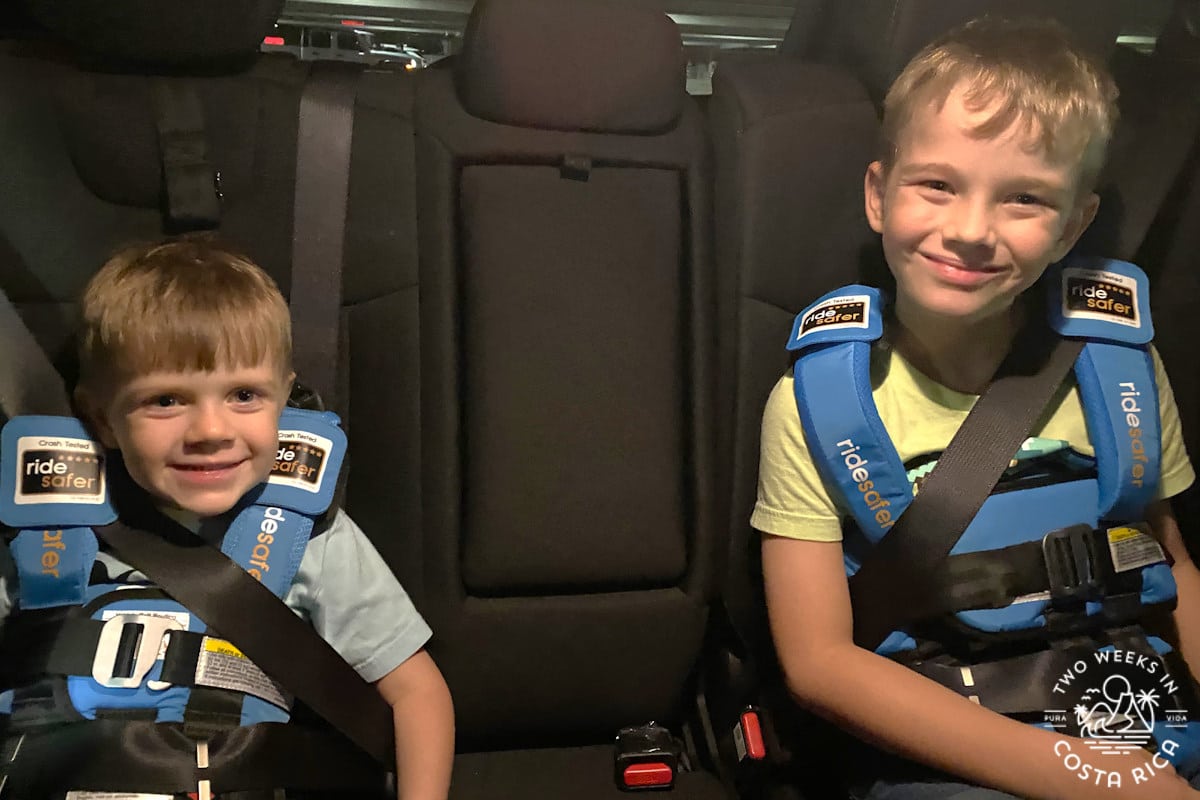
Final Tips and Helpful Car Seat Reminders for Travel
- Plan for extra time to install and adjust the seat in your rental car before getting on the road.
- If you rent a car seat and are not happy with the brand or model, ask the rental company if they have any others. They may have more in storage.
- If you bring your own seat and are taking a shuttle or taxi, inform the driver that you need an extra 5 minutes to get it installed. Costa Ricans are generally very patient and will likely help in any way they can.
- Most car seats have stickers on either side with simplified installation instructions. This can be really helpful if you don’t have the manual.
- It’s a good idea to carry an extra seat belt clip for situations where a vehicle’s seatbelts may not lock properly. This has happened to us in taxis/Ubers. The small and inexpensive metal clip can be a lifesaver.
We hope this post helped explain how car seats work in Costa Rica. If you have any questions, feel free to ask us below.
Some of the links in this post are connected to affiliate programs we have joined. As an Amazon Associate we earn from qualifying purchases.
Looking for more information to plan your family’s visit to Costa Rica? Check out these posts:
Costa Rica with Kids Travel Hub: Our comprehensive family travel page on the most important things to know when visiting Costa Rica with kids. We cover safety, accommodation options, best things to do, and lots more.
Packing List for Traveling with a Baby in Costa Rica: If you’re traveling with a baby, this post will help with those specific questions on what to bring.
Using ATMs and Credit Cards in Costa Rica: Learn about Costa Rica’s currency and if you will be able to use your credit card.



